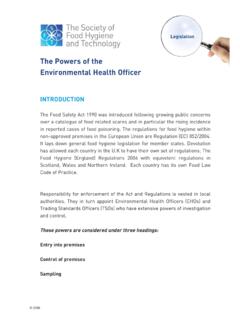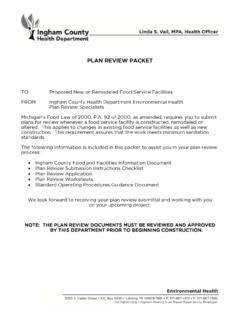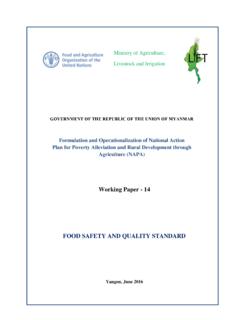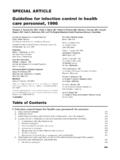Transcription of Pest control procedures in the food industry
1 Pest control procedures in the food industryJanuary 20092 ContentsIntroduction 3 food safety 4 Rodents 8 Cockroaches 10 Flies 12 Ants 14 Stored product insects 16 Birds and other vertebrates 20 Inspection and auditing of food premises 22 Pest prevention 28 Non-chemical control methods 37 Chemical control methods 40 Pest control contracts 46 Acknowledgements 50 Useful addresses 5131 IntroductionThe presence of pests in food production and preparation areas has always been unacceptable. Yet while the pest management industry has seen many advances in monitoring and baiting techniques in the past 30 years, some of the practices in the food industry have not kept up with these new for the environment and the requirements by regulators for improved practices in the industry have meant that new methods to control pests have had to be Chartered Institute of Environmental Health (CIEH) has assessed these developments and feels that now is the time to consider whether the techniques that have been common in the food and pest management industries need to be many of the people involved in maintaining and regulating food safety are environmental health practioners (EHPs)
2 , the CIEH has taken the lead in devising the standards which it believes should now operate in the food guidelines have therefore been drawn up by the National Pest Advisory Panel (NPAP) of the CIEH after full consultation with all those involved in food production, preparation and retailing, together with representatives of the pest management industry . Advice has also been sought from government agencies involved in research and enforcement, as well as the main bodies which lay down auditing guidelines are aimed at the food manufacturing sector. While the principles are the same for production (farmers and growers), raw material and ingredient suppliers, warehousing, distribution and retail, the level of pest control contract specification will CIEH would like to thank all those who have contributed to the preparation of these draft Stephen Battersby CIEH President OverviewThe presence of pests in any food handling premises is unacceptable.
3 The risks posed by pests include: The spread of disease pathogens are transferred from the gut or external surface of the pest Damage to property Contamination of work surfaces and foodstuffs Adverse public opinion and loss of reputation Prosecution and closure Poor staff relationsThe objective of the Pest management Programme should be to prevent, as far as practicable, the introduction of pests onto the site and to reduce the conditions that may encourage their presence. food Hygiene Regulation (EC) 178/2002 of the European ParliamentThis regulation lays down the principles and requirements of food law. Article 14 of Regulation (EC) 178/2002 deals with unsafe food . It is an offence not to comply with article 14 under the General food Regulations 2004.
4 food shall be deemed unsafe if it is considered to be injurious to health or unfit for human Regulation (EC) 852/2004 These regulations lay down general hygiene requirements for all food business operators and state that: The layout, design and construction of food premises are to permit good food hygiene practices including protection against contamination and in particular, pest control . Adequate procedures should be in place to control HaCCP HazarD analySiS CritiCal control POintAccording to EC Regulation No 852/2004 on the hygiene of foodstuffs, with the exception of activities at the level of primary production, food business operators are required to put in place procedures , which manage food safety within their establishment. Article 5 of the regulation requires that the procedure or procedures be based upon the HACCP (Hazard Analysis Critical control Point) principle.
5 However, it does not necessarily constrain food business operators to implement a HACCP system if this is not appropriate. Pest management is part of the Good Manufacturing Practices (GMP) for food businesses, which is a prerequisite for the HACCP-based procedures in place. As an integral part of the GMPs, it should be carried out with due diligence and properly PeSt management StanDarDS in tHe food inDuStryFood safety audits may be carried out by auditors from within the company or from an independent organisation. The audit is generally based on a series of criteria set out to ensure the highest standard of compliance with a specific aspect of food safety. The section which deals with pest management will usually require zero infestation and conformity with criteria covering type of pest management programme; permitted materials and techniques and record is essential when setting criteria to ensure that they achieve the required result.
6 Over prescriptive criteria may place unnecessary restrictions on the pest management programme, extending the period before control is Risk-based standardsIf standards and guidelines for pest control are to achieve the aim of promoting best practice they must be practical and flexible. The standard should be risk-based in order to address the issues raised by the following:Risk to public health due to activities of pestsPests are known to carry a range of pathogens which can be transmitted to humans either through contaminated food or their presence in the environment. Risk to food safetyThis will be the priority for all engaged in the production, storage, transport, processing and sale of food . The risks include:2 food safety5 Physical contamination of product by rodent droppings, insect parts or other foreign bodies Introduction of micro organisms Damage to product or packagingRisk to public safety and the environmentThe irresponsible or inaccurate use of pesticides may present a hazard to technicians, site staff and members of the general public, as well as to the environment through contamination of water, damage to plants and the effect on non-target species of Application of standardsWhen applying the relevant standard to pest management such as rodent control , reference should be made to the following: Are rodents active on site at the time of the inspection?
7 (Evidence of, or bait taken by, field mice or voles away from the buildings should not constitute an infestation) Past history of site. Is there documented evidence that rodents have been active in the last two years? Site potential for infestation. Does the layout, construction, manufacturing process, hygiene practices or product lend the site liable to infestation? Are there water courses, railways, amenity sites nearby. Is the site situated within or adjacent to a high risk area? Status of neighbouring properties. Are the activities of adjacent properties or businesses liable to attract pests into the vicinity? Presence of non-target species. Are there records or reported sightings of protected species of birds or mammals? Are there areas away from the buildings where the presence of toxic rodenticide baits may present a risk of secondary poisoning?
8 Environmental management and pesticide reductionThere should be an increased reliance on environmental management and inspection of the site to reduce the attraction to management programmes should aim to reduce the use of pesticides, particularly outdoors, by enhanced prevention programmes based on proofing and hygiene. For example, reliance on toxic rodent baits outdoors as a permanent indicator of rat activity is no longer acceptable. Knowledge of the site, its history and potential for infestation through regular and thorough inspections will replace perimeter baiting as the first line of defence. PeSt awareneSS anD StaFF trainingTraining should be given appropriate to the personnel concerned, for example using the CIEH DVD Pests on the Menu. As a minimum all departmental personnel should be aware of the pests that they are likely to encounter in their part of the process and the importance of pest prevention.
9 Particular attention should be given to incoming goods such as raw materials or packaging. 6 Pests and their habitsTraining on the identification and habits of the more common pests of the food industry can be given by the pest control contractor or through independent consultants. This is best achieved in the form of a brief presentation rather than distribution of literature, and where appropriate can be tailored to particular industry segments for example, bakery or preventionThe importance of pest prevention through good hygiene, stock management and exclusion practices should be emphasised. Site personnel have the day to day responsibility of ensuring a pest management programme is postersIn addition to training sessions the posting of information at individual workstations or sensitive locations such as rest areas and goods-inwards doorways can act as a reminder of the requirements of the Pest management Programme.
10 These can remind staff of pest-related risks and preventive measures such as: Door and window disciplines Hygiene and housekeeping Stock storage and rePOrting anD reCOrD KeePing The organisation of a reporting system and maintenance of records is essential if Good Manufacturing Practice (GMP) status is to be must be kept for the following reasons: To highlight any recommendations To demonstrate compliance with legislation To monitor pest management processes As evidence of compliance to third party Pest sightings logA record should be kept of any pest sightings, including those made by personnel other than those involved in pest management . This can be in the form of a book or a folder where the following information can be logged: Name of person making report Date and time Location Pest seen Any other relevant informationIn addition to entering the sighting in the book, the sighting must be reported to the appointed manager in charge of pest management who will decide on further action.







